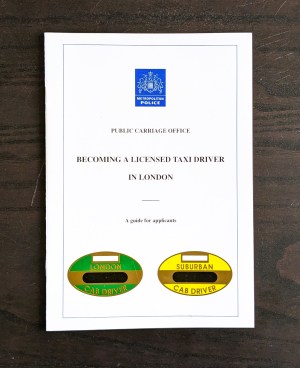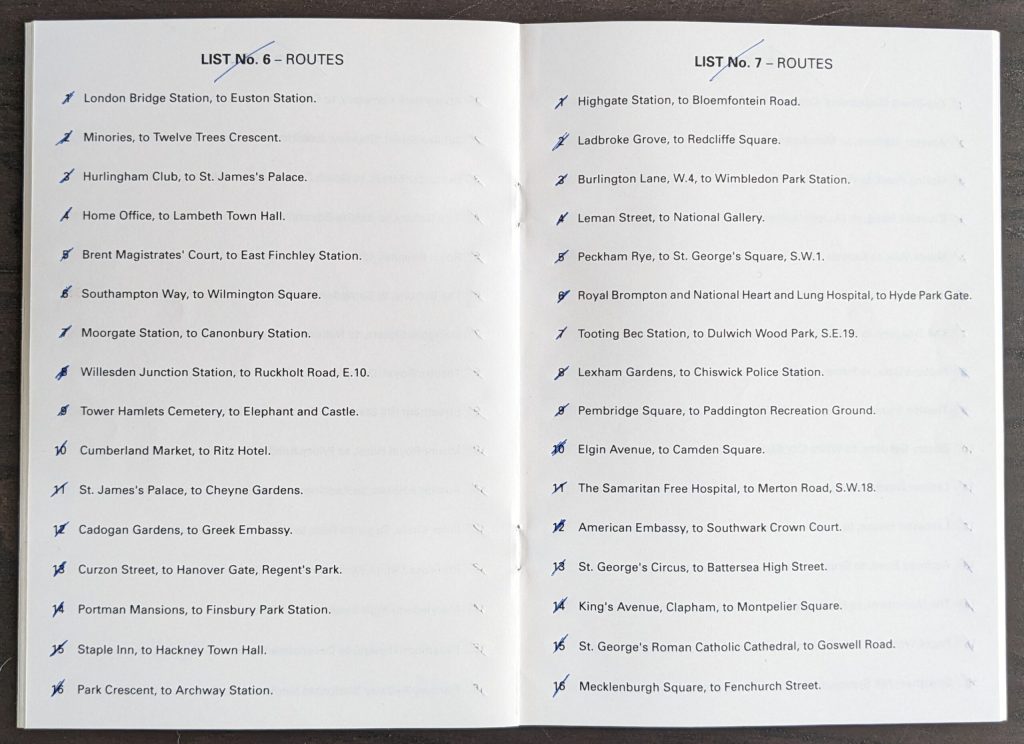‘Knowledge of London’ Definitive Guide – How to be a London cabbie in only three years!
- Every licensed London taxi driver has completed the Knowledge of London, a topographical test-of-endurance like no other.
- Nothing else like the Knowledge of London exists anywhere else in the world.
- There are no other taxi drivers like London taxi drivers anywhere else in the world.
I’ll explain what all that means.
A licensed London taxi driver is a taxi driver allowed to drive a real London taxi with a taximeter. To earn this privilege they must have first completed an arduous and unique training process known as ‘the Knowledge of London’.

Graham and his London taxi
The Knowledge of London, also known as ‘the Knowledge’ or ‘the KOL’ for short, began in 1865. It is the process by which a KOL student learns the streets of London, thousands of routes through those streets and thousands of buildings and landmarks on those streets.
From start to finish the Knowledge takes about three years. It is not a paid traineeship and for the dedicated student it becomes an all-encompassing way of life for the duration. There is a 66% drop-out rate.
KOL students are known for the duration of their training as a ‘Knowledge Boy’ or ‘Knowledge Girl’. They usually carry out their learning on scooters or motor bikes, identifiable by having a clipboard fixed between the handles. This clipboard will have maps and routes clipped onto it – everything the Knowledge student is learning on that particular day.

A Knowledge Boy

A Knowledge Boy
Examinations are by verbal assessments, one-to-one, face-to-face with an examiner and these can number anywhere between 15 – 20 over the three-year period. The Knowledge Boy or Girl aims to score points in every examination, based on their aptitude and knowledge. The more points they score the faster they progress. An exam is known as an ‘Appearance’.
Once a KOL student passes ‘the Knowledge’ they are allowed to drive a London taxi. They will have already covered 20,000 miles doing ‘the Knowledge’. London cabbies have certain privileges. We can be street hailed, we can rank (line) up at major transport hubs and locations in legally designated spaces and we can drive in bus lanes. A cabbie can rent or purchase a taxi, it’s their business decision. We are all self-employed.
Taxis can also be called cabs and taxi drivers are often called cabbie’s or perhaps generically a ‘black cabbie’ driving a ‘London black cab’ – although mine is a very dark midnight blue!

Knowledge of London – The Rules

Knowledge of London: The Rules, page 1 – you have been warned.
‘The Knowledge’ Process.
1. Learn the ‘Blue Book’. The Blue Book contains a list of 320 routes, or ‘runs’, that criss-cross London (400 runs when I did it in the late-90s). All the routes fall within a six-mile radius of Trafalgar Square. Every route must be learned by heart, from start to finish in as straight a line as possible. This is where the scooter asserts itself as the obvious vehicle of choice: fastish, manoeuvrable, easy to get off and on to check stuff.
At the start of each run about six landmarks, or ‘points’, have to be found and at the end of each run another six landmarks have to be found. All ‘points’ must be put to memory.
By the time the Blue Book is completed the KOL student will have learnt thousands of street combinations and approximately 3500 buildings: public, private, government, stations, embassies, courts, hospitals, places of worship, hotels, restaurants, theatres, cinemas, clubs, pubs, museums, art galleries, police, ambulance and fire stations, livery halls, HQs, retailers, markets, statues and memorials, cemeteries and crematoria, you get the picture.
Completing the Blue Book is the end of the beginning. It took me nine months.

Knowledge of London – The Blue Book

Knowledge of London. The Blue Book in long-form. Each sheet clipped to the scooter board for study on the move. See map below.
2. Join a ‘Knowledge School’. This is not a school in the traditional sense. It’s often a couple of big rooms somewhere rented by a ‘proprietor’ where KOL students gather to test and help each other. Some Knowledge Schools also publish the Blue Book in an easy-to-navigate long-form – which helped a lot. Constantly evolving teams, or ‘tables’, are created in the schools, where you join people at your own level with the idea that you meet at the school a few times a week to test each other on the Blue Book (it’s called ‘calling over’) …and what comes next.
What Comes Next.
3. ‘Cross Section’ runs. Six pink books covering north, south, east, west and central London each with 25+ small, tight little routes in them. Excellent for learning local one-way systems and some intensely dense areas in more detail. So that’s another 150 routes to run and learn.

Knowledge of London. The Blue Book in long-form. Each sheet clipped to the scooter board for study on the move.
4. ‘Daily Point Sheets’. Knowledge school’s will each have a ‘runner’ waiting outside the building where Appearances are held. The runners will ask every KOL student leaving the building what routes they were asked to call over in their examination. Appearances are always in the morning. Once the runners have the full morning’s list they rush back to their school where the proprietor types and prints the daily sheets ready for the students to study and call over to each other at their tables. Point sheets will have all the new points as well – more to find, more to remember. They say a newly qualified cabbie can recall 8000 points.
5. Appearances. Dress smart, suit or jacket and tie, remove earrings (if male), cover tattoos. Register on arrival and wait in the waiting room. As each examiner enters they will call a name. One will be yours. You follow the examiner to their room, sit down and face them across their desk. You call them ‘Sir’ or ‘Ma’am’. There might 15 seconds of relaxing small talk. Ha! Then the questions start. You can be asked anything anywhere (the Blue Book and cross section runs are merely a framework).
The examiner will ask you Point A. You tell them where it is. They will ask you Point B. You tell them where it is. They will then ask you to verbally run Point A to Point B, street by street using the most direct route. This process repeats four or five times. The examiner will then score you on your performance across all their questions based on: knowledge, accuracy, fluidity, speed of recall, errors, forgetfulness and of course lack of knowledge.

Knowledge of London – Point sheet (with thanks to Knowledge Point)
Here is a not untypical ‘Knowledge’ conversation:
Q: Did you score on your Appearance today?
A: No, the examiner gave me some nasty ‘stoppers’.
I’ll explain; one notorious examiner asked me to take him (as Point B) to ‘the longest stained-glass window in London’. Exactly. That is a ‘stopper’. ‘Appearances’ are designed to be a test of character as well as tests of topographical knowledge. A typical comment from an examiner if no points were scored at all might be ‘you need to get out on your bike more son’. Looking down at the floor you might simply whimper ‘yes sir’. I was a grown man when I did the Knowledge.
Until the early 2000s the KOL was run by the Metropolitan Police at the Public Carriage Office and most examiners were retired bobbies. The Public Carriage Office was not-quite-affectionately known as ‘the last bastion of the British Empire’. The KOL is now run by Transport for London.
6. Never stop. A typical day for a Knowledge student would be on their bike learning in the morning, then school in the afternoon going through the daily point sheet with their team. Every table will have a giant laminated street map of inner London pinned onto it. Each student in turn calls over a run from the list on the point sheet, their call over being marked with an erasable pen on the map by another team member. The straighter the line between points A and B the better the run. All in preparation for Appearances.
7. The Green Book. Appearances roll in multiples of seven days, depending on how well you’re doing. You will get your next Appearance dates in 56, 28, 21 or 14 days. At 14 days it’s ‘light at the end of the tunnel’ time. But not quite, because when it is ‘all over’ you will then be asked to do the Green Book, which is tested after 84 days. The Green Book has 66 very long runs, mainly to and from Heathrow and City airports and from mainline stations to the outer edges of Greater London.

Knowledge of London: The Green Book

Knowledge of London: The Green Book
Then it really is all over and you’re awarded your London Cab Driver badge at a small graduation ceremony.
Legacy.
- I have a job for life and the freedom to control my own timetable, but I will never be a millionaire.
- My hippocampi have become enlarged, and that is a scientific fact. The hippocampi are the parts of the brain that consolidate long-term and spatial memory.
- Being a London cabbie was a launch pad for me to become the tour guide and driver-guide I am today.

Graham and his old London taxi in 2014

Blue Book Runs 9/14 and 7/11 (see Blue Book image above). Both starting points of Middlesex Hospital and Samaritan Free Hospital no longer exist.
Note: the Knowledge is constantly changing and not every detail here may be 100% up-to-date.
